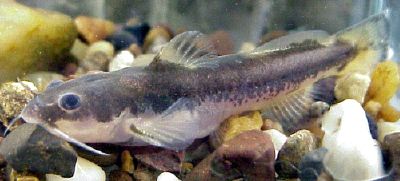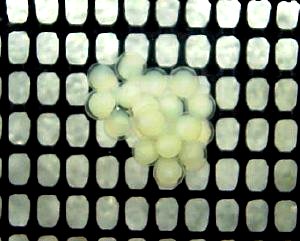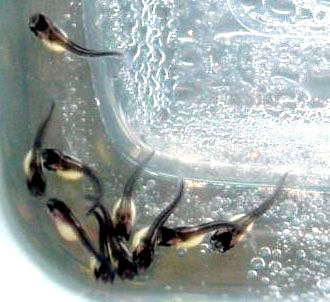SCOTCAT.COM
your internet guide to all things catfish
| Spawning the Rare Pygmy Madtom, Noturus stanauli |
by J. R. Shute |
Noturus stanauli
Noturus stanauli is known from only two widely separated localities in the Clinch and Duck rivers of the Tennessee Drainage. A search of the literature and museum records revealed that only about 25 museum specimens existed, and probably fewer than 50 individuals have ever been collected! This is in spite of extensive surveys by many fish folks collecting at both known localities and other nearby sites. Obviously, this is easily one of the rarest fishes in North America! The pygmy madtom is the smallest member of the genus Noturus. Adults are less than 50mm total length (TL). They are dark brown dorsally and nearly white ventrally. This contrast of dark and light is quite striking. Almost nothing is known of the biology of this rare madtom. Most specimens have been collected over shallow, fine gravel shoals with moderate to swift flow, usually near the stream bank. For years we have wondered about the possibility of propagating pygmy madtoms. It was clear that the species was too rare to think we would find nests to collect and rear. We have had limited success spawning other madtoms in our hatchery, mostly as a result of injecting hormones. Clearly, madtoms could be spawned in aquaria, but because of the rarity of this fish, and our reluctance to handle them, we would hope to find a natural trigger to induce spawning in these miniature catfish. Our chance came this past spring. On March 25, 2000, Dr. Rick Mayden and crew were in our area collecting fish to photograph for his upcoming book on the freshwater fishes of Alabama. The day before we had been out helping them collect snail darters, Percina tanasi in the Holston River. The following day, they made a collection in the upper Clinch River. Later that day we got a call from Rick. They had managed to collect two pygmy madtoms! They were aware of our efforts to propagate madtoms and told us that they would turn the specimens over to CFI. CFI is covered under the necessary federal and state permits to handle these federally protected species. We quarantined the two specimens in a 55 gallon aquarium. One of the two madtoms was considerably smaller than the other (the smaller was approximately 30 mm and the larger was around 35 mm TL). Since pygmy madtoms are thought to have a short, one-year lifespan, we were hopeful that the size difference was a gender difference, rather than an age difference. The aquarium was filtered with a large, air driven, sponge filter. A natural gravel and sand substrate was provided along with flat rocks and other cover items. The fish were fed heavily with live blackworms, Daphnia, mosquito larvae and frozen bloodworms (chironomid larvae). Both individuals adapted well and slowly increased in size. By early July, the larger specimen was becoming obviously gravid. The smaller one showed no signs of filling out. Also, for the first time since they were placed into the aquarium, they began to spend time under the same cover objects. At this point, we provided more cover, including empty mussel shells and a 6 x 6, unglazed ceramic floor tile. More current was added to the tank, using a small submersible water pump. Within a couple of days, the pair (at least we hoped they were a pair!) took up residence under the floor tile. Based on our other aquarium experiences, we had discovered that freshly laid madtom eggs are very difficult to handle and are much more likely to develop problems than ones that are several days old. Because of this, we chose to leave the fish undisturbed for about a week in hopes that if they did spawn, the eggs would stand a better chance of survival. On July 11th, we checked under the floor tile and found the male guarding a small clutch of eggs! The female was under an adjacent rock. The eggs were removed from the custody of the male and transferred to a plastic incubation tray filled with water from the parentsí tank. There were 10 live eggs and three empty chorions. The eggs measured approximately 3.8 mm in total diameter. Despite the small size of the pygmy madtom, the eggs are nearly as large as other madtoms we've had experience with. The eggs appeared to have been laid at least a couple of days earlier, and some showed distinct embryonic development.
After examining and measuring the eggs, they were placed onto a hatching platform, dubbed by Pat, a ìmadtom egg wagonî. The ìwagonî was constructed using plastic mesh (3x4mm) and PVC tubing. The platform was constructed to provide water movement all around the eggs, even from below. Water movement was facilitated using a small air stone placed near the eggs. Over the next few days several of the eggs turned opaque and died. Leaving dead eggs in the clutch invites fungal infection of the good eggs, so these were carefully removed by pipette, or by inserting the needle from a syringe into the egg and removing the contents. We were very careful not to damage adjacent eggs.. The first egg hatched on July 18th and by the next day, the rest had hatched. At this point, we were down to four larvae. It was not clear if development was progressing normally in the eggs that died, or if they were even fertile. Our reluctance to disturb the developing eggs prevented us from close observation. Over the next couple of days, the baby madtoms looked great. Because the larvae have large yolk sacs (as all madtoms do), feeding was not necessary until the larvae began actively swimming. By July 24th, one of the four larvae had died. This was right at the stage where the larvae were beginning their transition from reliance on their yolk to feeding on their own. The remaining three looked fine and were now accepting newly hatched Artemia nauplii. On July 29th, a second nest was discovered, being guarded by the male pygmy madtom. We had noticed the female still appeared to be somewhat gravid after the first spawn and were hopeful that a second spawn was possible. This nest was somewhat larger than the first, consisting of19 eggs. At the time we discovered the nest, these eggs were probably at about the same stage of development as the first clutch.
The second clutch of eggs were treated much the same as the first clutch. Again, there were some egg losses over the next couple of days, but this time we managed to bring 10 eggs to hatching! The first eggs hatched on August 8th, 10 days after collection. The spawning adults and incubated eggs were held at approximately 73 degrees F. At this point, the babies from the first spawn measured 18 mm TL! As the young madtoms grew, they were put together in a single 20 gallon aquarium which is part of a much larger aquarium system, and that is where we currently keep them. The young madtoms have adapted well to chopped, live blackworms. While the madtoms are rarely seen out from under cover, they do tend to be most active shortly after the lights go out in the early evening. For this reason, we believe that pygmy madtoms may be crepuscular. At the time of this writing, all 13 madtoms are doing great. They now measure 35 mm T L, which is as large, or larger than the adults we received from the Clinch River in March. In October, one of the parents died (it is not clear which one at this point). The remaining adult still looks good and is probably the oldest living pygmy madtom in the world! Our experience here opens up the possibility for reintroduction work with this and other rare madtoms. Already, we are able to look at several big-river sites and hope that some day they might serve as potential homes to this rare fish that almost certainly inhabited much of the upper Tennessee River in the past. This article
and photo's are From the Conservation
Fisheries, Inc. Newsletter
#2, 1 December, 2000 and are used on ScotCat
by permission. |
If you would like to contribute an article, please e-mail me. You will of course be credited for your work.
If you would like to donate any denomination of money to the site just click the above link button. All proceeds will go to running the site and hopefully to keep it going for a few years yet.
Print or e-mail this factsheet below




